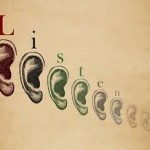 Listening is a really important skill both in our native languages and in the second language we learn. It is often a neglected area since most of us enjoy speaking more than listening. You see lots of people who are passionate about telling about their stories but when it is their turn to listen you may not always see that they are actually listening to YOU with their EARS, EYES, HEARTS and UNDIVIDED ATTENTION as in the Chinese script for the word ‘listen’.
Listening is a really important skill both in our native languages and in the second language we learn. It is often a neglected area since most of us enjoy speaking more than listening. You see lots of people who are passionate about telling about their stories but when it is their turn to listen you may not always see that they are actually listening to YOU with their EARS, EYES, HEARTS and UNDIVIDED ATTENTION as in the Chinese script for the word ‘listen’.
I wanted to share what I learned at a session which was attended by about 600 people at IATEFL 2011.  J.J. Wilson started with some metaphors while he was describing listening being a complex skill and said that ‘All speech is an illusion.’ Words run into each other and change shape like crashing cars. Listener has to imagine when one word ends and the other begins i.e.
J.J. Wilson started with some metaphors while he was describing listening being a complex skill and said that ‘All speech is an illusion.’ Words run into each other and change shape like crashing cars. Listener has to imagine when one word ends and the other begins i.e.
I scream for ice cream or Excuse me while I kiss the sky. This line was taken from Jimmy Hendrix and people thought he was saying I kiss this guy instead:)
Listening is difficult especially because speakers use colloquial language, idioms etc.
J.J. asked ‘What can we do to help our ss in listening’ then he wanted us to complete the following:
Listening is…..
I listen when ….
A good listener…
I completed them as follows:
Listening is hard to teach.
I listen when I am interested in the topic.
A good listener listens actively and uses paralinguistic features while building the meaning.
Afterwards, J.J. listed the strategies that good listeners use and said that:
 A good listener uses strategies;
A good listener uses strategies;
1.Take the ownership of the conversation
Good listeners see themselves as part of the interaction. Meaning is constructed.
They interact personally and they make emotional connection with what they listen to.
2. Provide constant feedback,
Good listeners make comments, say ‘Can you speak louder?’ or a gesture.
3. Good listeners are worldly listeners,
They use visual clues, look at the context, hands eyes and lips.
4. Good listeners are experts at self-monitoring,
They check how accurate their interpretations are.
5. Good listeners bear with ambiguity.
They can make hypothesis although they are provisional.
6. Good listeners question the completeness of their understanding.
They do not jump into conclusions with initial clues.
7. They identify specific areas.
Some people give up all when they cannot understand some parts.
Good ones say I didn’t understand that bit.
8. Good listeners listen between the words.
They don’t take utterances with face value. Sometimes people speak for more than one reasons to get what they want. Good listeners can differentiate what is genuine, what is purposeful.
9. Good listeners think ahead.
Predict what will happen next, they check the relationship between the speakers, and linguistic clues like on the other hand.
10. Good listeners focus on what is valuable.
They can tune in what is valuable, such as directions, instructions.
11. Good listeners listen to different things in different ways.
JJ asked ‘Is it worth teaching listening strategies, don’t they carry over from L1? and says ‘Well, we do need to teach them.’Ss are occupied with linguistic problems so they cannot transfer what is acquired into real life easily.
How can we teach them then? Is it really possible?
 Yes, it is possible. Research says so e.g. Oxford, R.L. (1990). Language learning strategies: What every teacher should know., O’Malley, J. M., & Chamot, A. U. (1990). Learning Strategies In Second Language Acquisition. New York: Cambridge University Press.
Yes, it is possible. Research says so e.g. Oxford, R.L. (1990). Language learning strategies: What every teacher should know., O’Malley, J. M., & Chamot, A. U. (1990). Learning Strategies In Second Language Acquisition. New York: Cambridge University Press.
Firstly we can teach these strategies through questioning and activities, in time they will ask the same questions to themselves
Some activities:
a) Listening to the same text for different purposes
1. The activity starts with filling in a classic KWL chart in pairs about the topic J.J. will be reading us about, in this case it was about the autistic children, as in Rain Man.
2. He reads a text and asks how many of our questions form the L section of the chart were answered.
3. He reads the text again. This time he invites 3 volunteers who would grab the word cards selected from the text and stuck on the wall. He reads the story again while the volunteers are competing to grab the most word cards from the wall. The one who has caught the most wins. Here, by means of this selective listening for key vocabulary, he intends to make students to hear the collocations.
4. He reads the same text again with pauses. This time, he asks the audience to complete the missing words such as ‘of’, ‘to’ and some other simple words. Here students use the linguistic knowledge while completing the sentences orally.
b) Hitting hands game
Students work in pairs as As or Bs. Their palms face to one another’s. If a student hears the word that has been assigned to him/her, he/she hits the other’s palm(s) while his/her partner tries to avoid it.
– The first couple of words were Kim and King, Box and Boxes. For example As are assigned to hit when they hear the words Kim and the Bs can hit when they hear the words King and Boxes.
– Then J.J. assigned As to listen to the words with two syllabi and Bs to catch the words with three syllabi, and he said words like physical, teenager, common, etc..
c) Reconstructing an anecdote
Pair A tells a story twice, Pair B can’t take notes. B does the same and A can’t take notes. Then, they write each other’s stories as much as they remember using 1st person without asking any questions to each other. Then they exchange the stories and make corrections. Finally they recite each other’s stories without looking at the written paper.
d) Listen for your word
Teacher says some words/phrases that he selected from the story he would read out. First students in groups guess what the story will be about. Teacher reads the original story, students compare it with their stories.
Students are given the same words, teacher asks students to stand up and reads the story again. When students hear th eir word they sit down.
eir word they sit down.
He reads the same story again by giving wrong information and asks students to say ‘wrong’ when they hear anything that is different from the original story..The are also supposed to give the correct information.
J.J. concludes with his final remarks on listening skills; discuss listening, vary the tasks, get them do smth with the info, personalize, use physical activities, give them a transcript to show the text in the written, play with/ change the texts.
Last but certainly not least, provide a good model by being good listeners.
 Most of us, as language teachers, often leave the classroom saying ‘Today, I taught the simple present tense OR the countable and the uncountable nouns, OR the past tense with irregular verbs.’ Yes, we do, don’t we? Then we sometimes say ‘I spent the whole week teaching the simple present tense, and they still forget the rule for the 3rd person singular.’
Most of us, as language teachers, often leave the classroom saying ‘Today, I taught the simple present tense OR the countable and the uncountable nouns, OR the past tense with irregular verbs.’ Yes, we do, don’t we? Then we sometimes say ‘I spent the whole week teaching the simple present tense, and they still forget the rule for the 3rd person singular.’















